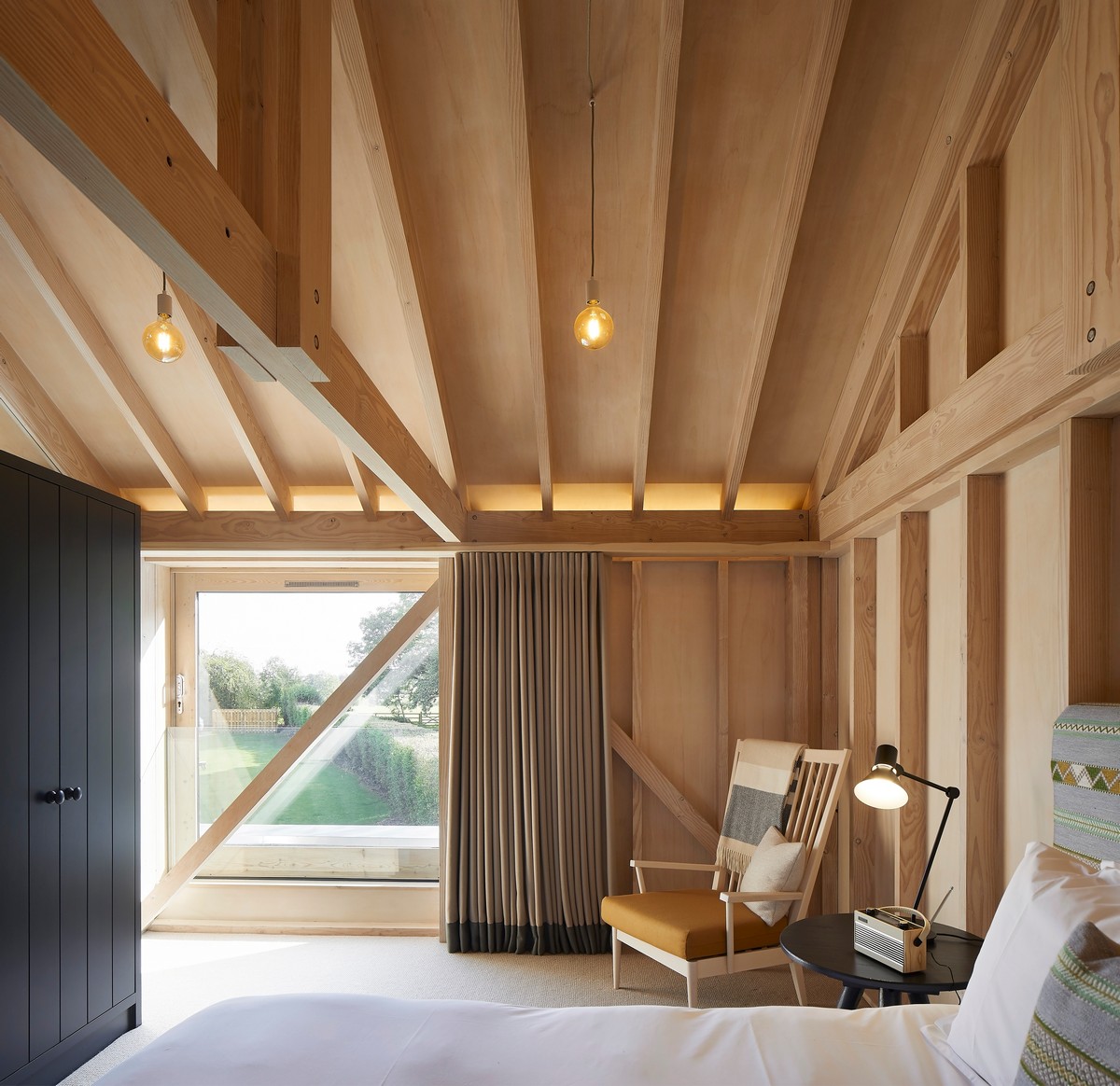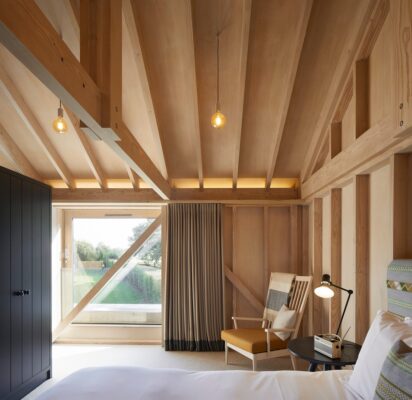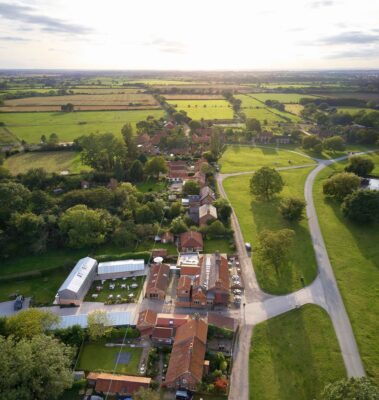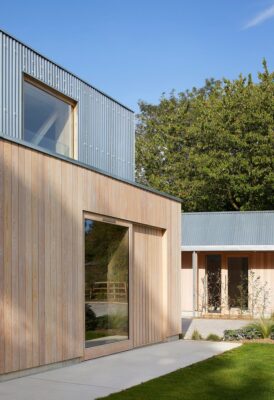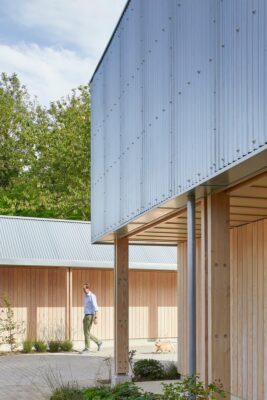The Alice Hawthorn Nun Monkton, Yorkshire Restaurant Architecture Photos, Harrogate Public House
The Alice Hawthorn in Nun Monkton, Yorkshire
13 Sep 2022
WAF 2022 Finalists for the Special Prizes News
World Architecture Festival (WAF) has announced the 2022 Special Prize shortlist ahead of this year’s festival. The projects shortlisted for the Special Prizes have been selected from across the greater WAF Awards shortlist, and this building is shortlisted:
WAF 2022 Special Prizes Finalists
23 June 2022
RIBA Awards 2022 Winning Buildings and Architects
The Alice Hawthorn by De Matos Ryan is the sole winner amongst 29 winning buildings in the 2022 RIBA National Awards for architecture.
25 May 2022
Triple Win For The Alice Hawthorn At RIBA Regional Awards
Location: Harrogate district, North Yorkshire, northern England, UK
This is one of four projects have been awarded Royal Institute of British Architects (RIBA) Yorkshire Awards.
Design: De Matos Ryan
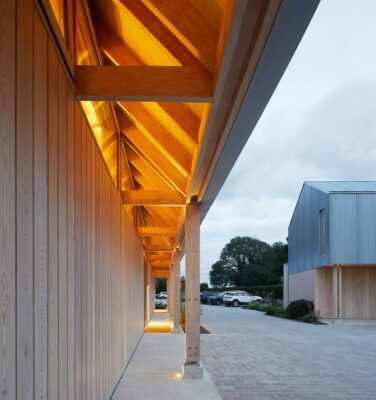
photos © Nick Hufton, Hufton and Crow
The Alice Hawthorn Inn – Award News
The Alice Hawthorn was awarded a 2022 RIBA Yorkshire Award at a ceremony held at RIBA’s London HQ last night. The project was also selected as the winner of the 2022 RIBA Yorkshire Sustainability Award and the 2022 RIBA Yorkshire Client of the Year Award. De Matos Ryan Director Angus Morrogh- Ryan comments, “We are delighted that this project has been recognised by the RIBA Yorkshire jury in this way. It has been an honour to collaborate with such a brilliant client and contractor team, and together ensure that this village pub will continue to sustainably service its community but also welcome visitors from afar.”
De Matos Ryan transformed The Alice Hawthorn’s sustainability with the addition of twelve guest bedrooms and the renovation of its Grade II listed pub. At the confluence of the Rivers Ouse and Nidd, the village of Nun Monkton was historically an important Northern trade hub for the medieval river transport network, with many travellers stopping overnight. The increase in road travel saw fewer travellers passing through, which eventually led to its demise as a trade and social point.
The closure of the village’s four taverns is sadly consistent with socio-economic and legal changes impacting pubs across the country. Named after a famous 19th Century racehorse, The Alice Hawthorn is the village’s last remaining pub. In recent years, this critical meeting point and social hub for the local community was in economic decline and had come under threat.
Creating an innovative new economy around assets such as the village pub is essential to the health and well-being of any rural community. Before the client took ownership in 2013, the pub struggled commercially and had even closed for a period in 2007. Despite significant investment in a new kitchen and the wholesale refurbishment of the ground floor pub spaces, it was not yet a sustainable business.
To become solvent long-term, it needed to increase its appeal to a broader audience. Therefore, the brief was to provide tourists, as well as the local community, with a high-quality but affordable basecamp from which to enjoy the surrounding landscape and visitor attractions.
Close, collaborative consultations with Harrogate Borough Council and the local community informed the project’s design. During these consultations, one villager noted that arriving home at night and seeing the pub lights on always gave them a warm feeling of contentment and calm. To see these switched off permanently would ostensibly remove a key organ of the community.
It was therefore incredibly important to save the pub from extinction. Community needs were considered at every stage of the design process and the scheme was tweaked, changed and reconfigured to acknowledge local feedback. The redevelopment has created new revenue streams for the restaurant and bar business, improved visitor footfall and dwell time and, most critically, increased propensity to spend within the local economy.
The scheme includes twelve ensuite guest bedrooms, four on the first floor of the pub and eight around a new courtyard, which extends the village green into the pub’s rear garden. The project takes its inspiration from the Norse ‘garth’ (‘grassy cloister’ or ‘clearing in the woods’), creating a sense of quiet enclosure and a notional extension of the village green: a place of gathering.
The design reflects the character of the various informal farmsteads that surround the green, which continues to be grazed by cows and other animals. The home-grown Douglas fir framed buildings use authentic agricultural building materials, such as galvanised corrugated steel roofing and larch cladding, to create the sense that the animals have only recently moved out. A simple and honest construction typology ensures that the project looks like the way it was built. The guest bedrooms are supported by new ancillary service areas, including housekeeping and linen stores, and staff accommodation.
The new timber frame buildings include the Sheds, Field Barn, Stables and Tack Room. Double member ‘cloister’ columns engage stainless steel feet sitting on cast concrete upstands. Adjacent to the front gate, the Sheds is a single-storey infill building between existing brick outbuildings with two staff bedrooms and a bathroom. It is clad in larch with a pan-tile roof to match the outbuildings. The Field Barn is a south facing, two-storey structure with four guestrooms.
The lower level is clad in larch while the upper level is sinusoidal galvanised steel. There are no windows to the north and west to prevent overlooking and light pollution to the neighbours. The Tack Room, a single-storey structure with a wheelchair accessible guestroom, sits adjacent to the west boundary and the Field Barn. It also provides shelter to the outdoor kitchen, pizza oven and pub garden bar. Adjacent to the east boundary, the Stables is a single-storey extension structure with three guest rooms.
Both the Stables and the Tack Room are clad in larch with a sinusoidal galvanised steel roof and back wall. Each guestroom is announced externally by a hand painted motif of the room names, such as Saddle, Stirrup, Flax, Barley, Wheat and Hay. Internally, in contrast to traditional pub interiors, the new build elements have no plaster and are lined with larch boarding and poplar plywood. Subtle distinctions between the timber species are blurred by a tinted treatment. The only internal wall decorations are lino cut prints created by village primary school children, who have a vegetable patch at the rear of the garth.
Sustainability is at the heart of the project’s design. A ground source heat pump provides heating and hot water, supplied by bore holes and supported with high levels of non-combustible mineral wool insulation and airtightness to a standard higher than current Part L2A building regulations. The timber frame buildings are naturally ventilated through use of high-level clerestory windows and rooflights on actuators. Solar gain is reduced by roof overhangs, which offer shading. LED and low energy lighting, as well as low volume water appliances, have been fitted throughout. The sustainable drainage system includes permeable paving and surface water attenuation tanks concealed below the pub garden.
A particular challenge was to develop a 1-hour fire resisting timber frame wall within 1m of the site boundaries. This was resolved by employing a fire resisting sheathing internally, thus avoiding carbon heavy blockwork. To ensure accessibility for all, level threshold access is provided to all buildings. On completion, the new builds scored an EPC ‘A’ rating. Biodiversity has been improved on site through extensive planting and habitat creation. The new courtyard is bounded by borders planted with native species, which also help screen the adjacent bedrooms. An orchard at the back of the site, which would have been typical of these plots in medieval times, is being re-established with fruit trees and will ultimately supply the pub’s kitchen.
Client and Nun Monkton local Kate Harpin comments, “We were very excited with the shape of the plans as they evolved, and the finished result has exceeded our expectations. We have twelve beautiful guest bedrooms, every one of them perfect in its own way. The beer garden has been flanked by the new buildings, making an atmospheric, sheltered and relaxing place to enjoy a pint and a tasty plate. The buildings, imagined as agricultural stables, stores, and barn, work brilliantly in our setting, and I have no doubt will get even better with age and weather. However, best of all, our guests love it, and the sense of pride exuded by the staff is wonderful. Since reopening, business has never been better.”
The Alice Hawthorn Inn, Yorkshire – Building Information
PROJECT CREDITS
Architect: De Matos Ryan
Project Manager: Russell Pickering, R Pickering Ltd
Quantity Surveying: Aspect 4 Ltd
Structural Engineering: Price Myers
MEP Services: P3r
Acoustics: Gillieron Scott Acoustic Design
Sustainability: Award Energy
Main Contractor: Gem Construction
Douglas Fir Timber Framing: Timber Workshop
Galvanized steel cladding: Varla
Timber Cladding, Doors, Windows & Carpentry: Lee & Micklethwaite
Mechanical Services: Warmaway
Electrical Services: Switched Solutions
Garden Designer: Kate Guillebard
Previously on e-architect:
5 May 2022
The Alice Hawthorn, Harrogate district, North Yorkshire, northern England, UK
Design: De Matos Ryan
The Alice Hawthorn Inn, Nun Monkton News
Jury Report
Nestled to the south of the central village green within the north Yorkshire village of Nun Monkton, sits The Alice Hawthorn public house, the only remaining pub in the village.
Bought in 2013 by the client, the pub had seen better days, suffering from a lack of ongoing investment both to its retail offer and to the Architecture of a Grade II listed building.
With a stage by stage approach, the new owners set about reinvigorating the pub as a vital community asset, repairing and refurbishing the existing building, creating a reputation for a high quality pub and restaurant
Their ultimate vision to secure the pub’s sustainability was realised in 2020 with the addition of twelve guest bedrooms, 4 within the existing building and 8 within a new courtyard development on the former car park to the rear.
Using inspiration from the farmyards or ‘garths’ commonly found to the back land areas of North Yorkshire villages, the courtyard format provides a well-proportioned collection of timber framed buildings which very much at ease with their rural setting and in turn, provides a hansom backdrop to the listed pub.
Careful use of a restricted palette of robust, agricultural materials, such as larch timber, wire brushed concrete and corrugated steel cladding are deftly handled, exposing the British grown Douglas fir frame, providing an honesty of construction which resonates very clearly with the simplicity of local farmstead buildings.
The positioning of the displaced customer car parking to the rear, allows the courtyard to be grassed, providing a softness which is welcomed by guests with young families allowing children to let off steam, whilst also creating a space for outdoor summer dining.
The rooms themselves are designed with the same rigor and consistency of the exterior, with a beautiful balance of natural exposed timbers, Douglas fir and poplar faced ply, complimented by carefully chosen soft furnishings and fittings which vary slightly from room to room making each room warm and inviting. The use of carefully framed artwork from the local primary schoolchildren is a particularly nice touch!
The use of sustainably sourced timber, a ground source heat pump for heating and hot water and air tightness levels and insulation standards, all in excess of Building Regulation standards, resulting in an EPC ‘A’ rating. Combined with the wider aspects of retaining an existing building for long-term use, it was felt appropriate to award the project the ‘Sustainability Award’ for 2022.
Making a significant financial investment and working closely with a talented Architectural practice, the client has managed to realise their vision of a viable long-term community asset which provides more than food and drink and a place to stay. Together, they have created a project which exudes quality but in a simple, unfussy and robust way, fit for our times. For this, they are to be congratulated.
RIBA region: Yorkshire
Architect practice: De Matos Ryan
Date of completion: Jul 2020
Date of occupation: Aug 2020
Client company name: Mr & Mrs Richard Harpin
Project city/town: York
Contract value: Confidential
Gross internal area: 905.00 m²
Net internal area: 638.00 m²
Cost per m²: Confidential
Contractor company name: Gem Construction
Consultants
Structural Engineers: Price Myers llp
Project Management: R Pickering ltd
Quantity Surveyor / Cost Consultant: Aspect 4 ltd
Acoustic Engineers: GSA Acoustics
Environmental / M&E Engineers: P3r
Awards
• RIBA Regional Award
• Regional/RSAW Client of the Year
• Regional/RSAW Sustainability award
• Regional Award Short List
2022 RIBA Yorkshire Award Winners
2022 RIBA Yorkshire Award Winners
The Alice Hawthorn, Nun Monkton – 2022 RIBA Yorkshire Awards Winner images / information received from the RIBA
Location: Yorkshire, northern England, UK
Leeds Architecture
Carnegie School of Sport
Design: Sheppard Robson
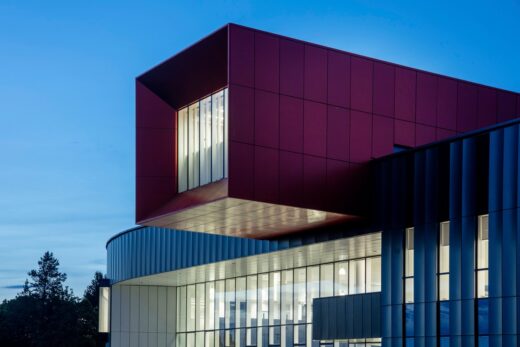
photo © Andrew Heptinstall
Carnegie School of Sport Leeds
Maggie’s Yorkshire
Design: Heatherwick Studio
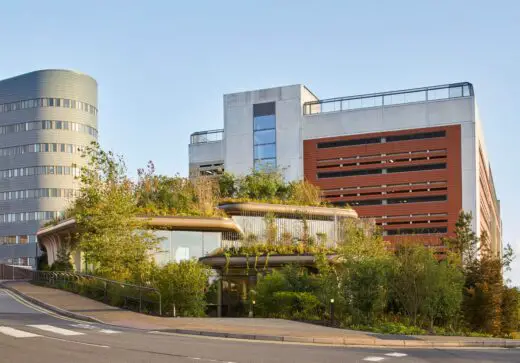
photo © Hufton and Crow
Maggie’s Yorkshire Centre Building
Pin Yard, Siddall Street, Holbeck Urban Village area
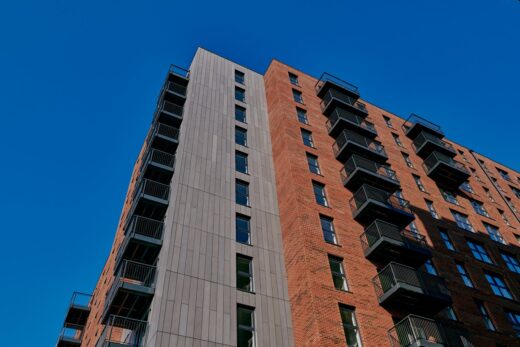
photo courtesy of Grainger plc
Pin Yard Leeds Apartments, Holbeck Urban Village
York Minster’s Centre of Excellence
Design: tonkin liu
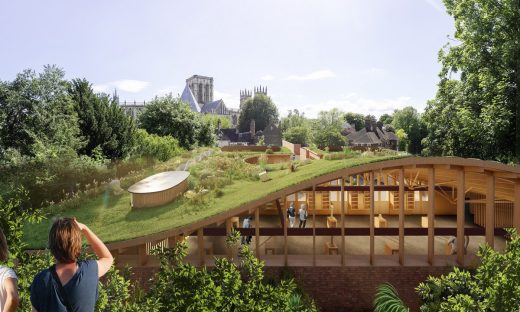
image courtesy of architects practice
York Minster Centre of Excellence Building Design
Leeds Playhouse
Design: PagePark Architects
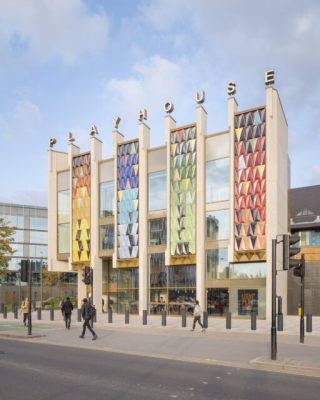
photograph : Jim Stephenson
Leeds Playhouse Building
York Theatre Royal Building Redevelopment
Design: De Matos Ryan
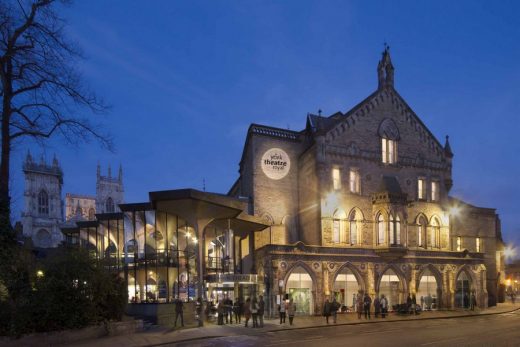
Artists’ Impression : De Matos Ryan
York Theatre Royal Building
English Architecture Designs – chronological list
RIBA Yorkshire Awards Winners
Yorkshire Architecture Awards
2022 RIBA Yorkshire Awards Shortlist
RIBA Yorkshire Awards Winners in 2018
Comments / photos for the The Alice Hawthorn, Nun Monkton – a 2022 RIBA Yorkshire Awards Winner page welcome

